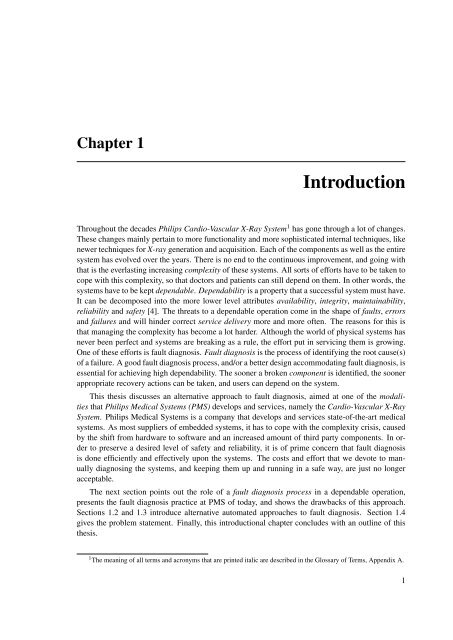pdf download - Software and Computer Technology - TU Delft
pdf download - Software and Computer Technology - TU Delft
pdf download - Software and Computer Technology - TU Delft
You also want an ePaper? Increase the reach of your titles
YUMPU automatically turns print PDFs into web optimized ePapers that Google loves.
Chapter 1<br />
Introduction<br />
Throughout the decades Philips Cardio-Vascular X-Ray System 1 has gone through a lot of changes.<br />
These changes mainly pertain to more functionality <strong>and</strong> more sophisticated internal techniques, like<br />
newer techniques for X-ray generation <strong>and</strong> acquisition. Each of the components as well as the entire<br />
system has evolved over the years. There is no end to the continuous improvement, <strong>and</strong> going with<br />
that is the everlasting increasing complexity of these systems. All sorts of efforts have to be taken to<br />
cope with this complexity, so that doctors <strong>and</strong> patients can still depend on them. In other words, the<br />
systems have to be kept dependable. Dependability is a property that a successful system must have.<br />
It can be decomposed into the more lower level attributes availability, integrity, maintainability,<br />
reliability <strong>and</strong> safety [4]. The threats to a dependable operation come in the shape of faults, errors<br />
<strong>and</strong> failures <strong>and</strong> will hinder correct service delivery more <strong>and</strong> more often. The reasons for this is<br />
that managing the complexity has become a lot harder. Although the world of physical systems has<br />
never been perfect <strong>and</strong> systems are breaking as a rule, the effort put in servicing them is growing.<br />
One of these efforts is fault diagnosis. Fault diagnosis is the process of identifying the root cause(s)<br />
of a failure. A good fault diagnosis process, <strong>and</strong>/or a better design accommodating fault diagnosis, is<br />
essential for achieving high dependability. The sooner a broken component is identified, the sooner<br />
appropriate recovery actions can be taken, <strong>and</strong> users can depend on the system.<br />
This thesis discusses an alternative approach to fault diagnosis, aimed at one of the modalities<br />
that Philips Medical Systems (PMS) develops <strong>and</strong> services, namely the Cardio-Vascular X-Ray<br />
System. Philips Medical Systems is a company that develops <strong>and</strong> services state-of-the-art medical<br />
systems. As most suppliers of embedded systems, it has to cope with the complexity crisis, caused<br />
by the shift from hardware to software <strong>and</strong> an increased amount of third party components. In order<br />
to preserve a desired level of safety <strong>and</strong> reliability, it is of prime concern that fault diagnosis<br />
is done efficiently <strong>and</strong> effectively upon the systems. The costs <strong>and</strong> effort that we devote to manually<br />
diagnosing the systems, <strong>and</strong> keeping them up <strong>and</strong> running in a safe way, are just no longer<br />
acceptable.<br />
The next section points out the role of a fault diagnosis process in a dependable operation,<br />
presents the fault diagnosis practice at PMS of today, <strong>and</strong> shows the drawbacks of this approach.<br />
Sections 1.2 <strong>and</strong> 1.3 introduce alternative automated approaches to fault diagnosis. Section 1.4<br />
gives the problem statement. Finally, this introductional chapter concludes with an outline of this<br />
thesis.<br />
1 The meaning of all terms <strong>and</strong> acronyms that are printed italic are described in the Glossary of Terms, Appendix A.<br />
1
















